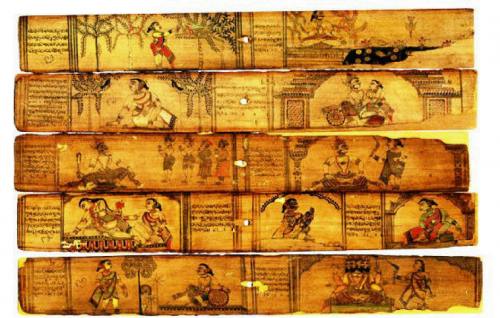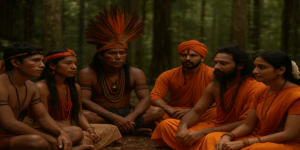Pandit Vamadev Shastri shows how western academics and Indologists lack the insight to the deeper meanings behind Vedic Symbolic Language used in the Vedas to come to their conclusions.
The Twofold Modern Denigration of the Vedas: Historical and Spiritual
 The nineteenth era marked a twofold assessment of Vedic culture that arose from western scholars and their examination of the Vedas.[i] First and most important to the new Western scholarship was the idea that the Vedic people came from outside of India by invading white skinned Aryans, who were more European than Indian in ethnicity. These so-called Aryans were also deemed as primitive and nomadic like the other Central Asian tribes at the time. India’s idea of a great history and antiquity for the Vedas inside of India was rejected. The Vedas were dated to merely 1500 BC. The traditional idea of a great antiquity for the Vedas extending to previous yugas or world-ages was rejected. This was the basis of the Aryan Invasion theory, which has changed in form over the years, but remains an Outside India origin for the Vedic people.
The nineteenth era marked a twofold assessment of Vedic culture that arose from western scholars and their examination of the Vedas.[i] First and most important to the new Western scholarship was the idea that the Vedic people came from outside of India by invading white skinned Aryans, who were more European than Indian in ethnicity. These so-called Aryans were also deemed as primitive and nomadic like the other Central Asian tribes at the time. India’s idea of a great history and antiquity for the Vedas inside of India was rejected. The Vedas were dated to merely 1500 BC. The traditional idea of a great antiquity for the Vedas extending to previous yugas or world-ages was rejected. This was the basis of the Aryan Invasion theory, which has changed in form over the years, but remains an Outside India origin for the Vedic people.
Second, and as a corollary, the Vedas were pronounced as containing little by way of advancement in religion, philosophy or culture. The traditional idea in India of a great spirituality in the Vedas was also rejected. Such scholars saw only a crude polytheism in the Vedas that in their estimate was far inferior to Jewish monotheism. This idea that the Vedas were primitive fitted in well with their Aryan Invasion Theory or nomads or barbaric hordes. As part of this estimation, these western scholars also found little of karma, rebirth, Yoga or any pursuit of higher awareness in Vedic texts such as characterized later Indic spirituality. They only recognized in the Vedas what they called Brahmanism, a kind of caste based nature worship, with little sense of the later Dharmic traditions of the country, Hindu or Buddhist, and their meditation approaches. [ii]
The beliefs that most Indians had regarded as the basis of their spiritual systems, like karma and rebirth, were regarded as something that derived from outside of the Brahmanical Vedic tradition or were pre-Aryan or non-Aryan in nature. Western scholars saw the Vedas much like the mythology and legends of their own pre-Christian European forefathers, with Vedic Indra on par with the Germanic Thor, a personification of masculine power only. They used European mythology to interpret Vedic texts and rejected the Indian tradition’s view of a great spirituality or Yoga teachings in the Vedas.
This twofold negative assessment of the Vedas can be summarized. The Vedic people and the Vedic culture derived from outside of India at a relative late time in ancient history and were largely primitive in nature. If India had any claim to spirituality or cultural greatness it came from pre-Vedic or non-Vedic traditions, traditions that were non-Brahmanical or anti-Brahmin. The effect of this was to throw what the Hindus had regarded as their oldest and greatest scriptures into the ground!
Questioning These Misunderstandings of Vedic Texts
 On the first point, the Aryan Invasion soon later became a migration theory when the Invasion theory failed to prove itself and it has continued downhill since. There has been in recent years a major reassessment of the history of India that is questioning this theory, if not rejecting it. New archeological finds, the discovery of ancient river courses like that of the Sarasvati, the findings of archaeo-astronomy, and new genetic information suggest that the Vedic people were indigenous to India, and the vast Harappan urban culture, the largest in the world at the time (3100 – 1700 BCE), was a Vedic or post-Vedic culture. While this view has not been universally accepted, it has emerged as a real possibility and is growing in adherents. Meanwhile any evidence for an Aryan invasion or migration, either archaeologically or genetically has yet to be substantiated.
On the first point, the Aryan Invasion soon later became a migration theory when the Invasion theory failed to prove itself and it has continued downhill since. There has been in recent years a major reassessment of the history of India that is questioning this theory, if not rejecting it. New archeological finds, the discovery of ancient river courses like that of the Sarasvati, the findings of archaeo-astronomy, and new genetic information suggest that the Vedic people were indigenous to India, and the vast Harappan urban culture, the largest in the world at the time (3100 – 1700 BCE), was a Vedic or post-Vedic culture. While this view has not been universally accepted, it has emerged as a real possibility and is growing in adherents. Meanwhile any evidence for an Aryan invasion or migration, either archaeologically or genetically has yet to be substantiated.
 However, the second point – the so-called primitive nature of ancient Vedic culture, and its lack of connection with later Hindu spirituality – has not been challenged as much in the popular mind or in the academic world, though the great gurus of India never accepted it. This second point needs to be countered like the first and the two are related. If the Vedic teachings reflect the basis of the great Harappan urban culture of ancient India, the Vedas should contain a corresponding sophistication of thought and cannot simply have been primitive poetry.
However, the second point – the so-called primitive nature of ancient Vedic culture, and its lack of connection with later Hindu spirituality – has not been challenged as much in the popular mind or in the academic world, though the great gurus of India never accepted it. This second point needs to be countered like the first and the two are related. If the Vedic teachings reflect the basis of the great Harappan urban culture of ancient India, the Vedas should contain a corresponding sophistication of thought and cannot simply have been primitive poetry.
In this regard, many of the thinkers who challenged the Aryan Invasion theory have also countered the negative estimation of the spiritual value of Vedic texts. Most notable is Sri Aurobindo who unfolded the spiritual secrets of the Vedas in his books like the Secret of the Veda, and Hymns to the Mystic Fire. He found in the Vedic Agni the Divine will towards transformation taking the soul through various births in its ascent into the Godhead. He also brings in such Vedic insights into his study of the Upanishads, which he connects closely to the older Vedic teachings.
Aurobindo’s views on the spiritual power of the Vedas provided an inspiration for many other writers in the field including those who challenged the Aryan invasion theory like Ram Swarup, Sitaram Goel, KD Sethna, Francois Gautier and myself.
 Kavyakantha Ganapati Muni, the chief disciple and spiritual brother of Ramana Maharshi, had the same ideas of the spiritual and yogic greatness of the Rigveda. He identified the Vedic Agni with the individual reincarnating soul (an idea we find in the Upanishads and later texts as well), and saw in the hymns of Parashara in particular (Rigveda Il.65-73), a glorification of spiritual knowledge.
Kavyakantha Ganapati Muni, the chief disciple and spiritual brother of Ramana Maharshi, had the same ideas of the spiritual and yogic greatness of the Rigveda. He identified the Vedic Agni with the individual reincarnating soul (an idea we find in the Upanishads and later texts as well), and saw in the hymns of Parashara in particular (Rigveda Il.65-73), a glorification of spiritual knowledge.
Like the unborn (or goat, aja) he supports the Earth. And he upholds Heaven with the mantras of truth. Guard the beloved stations of the soul. O Agni as the immortal life enter secretly into the secret place (of the heart).
Rig Veda I.67.3
They all worship the Divine Name (Devatvam Nama), following the immortal truth according to their ways.
Rigveda I. 68.2
The Rishi Vamadeva is quoted in the Upanishads (Brihadaranyaka I.IV.10) relative to the great statement or Mahavakya “I am Brahman (aham Brahmasmi),” for his own statement of “I was Manu and the Sun” (RV IV.26.1). This means that Upanishads quote the Rigveda for the highest Self-realization and do not regard it as something new or non-Vedic. Vamadeva also proclaims:
The entire universe dwells within your own nature, in the heart, in the ocean, in all of life.
RV IV.58.12.
Paramahansa Yogananda of the Autobiography of a Yogi fame described his own Kriya Yoga practice as a reflected in the Vedic fire worship.
The Unity of Kings and Rishis, Brahma and Kshatra in the Vedic Teaching
In the Upanishads some teachings are given by kings, not by Brahmins, including an important section that discusses the process of rebirth. Western scholars have used phenomena like this to hold that teachings like rebirth were non-Brahmanical or non-Vedic, because they were taught by kings, not by Brahmins. However, the Vedas back to the Rigveda are not simply Brahmanical texts but also highly honor great kings and great merchants. In Vedic thought Brahma and Kshatra or spiritual and worldly power go together, just as in the Sikh tradition.
Where Brahma and Kshatra work in common together, may I know that pure realm where the Devas are together with Agni.
Shukla Yajur Veda 20.25.
The Vedas reflect a warrior spirit, and are not just a glorification of priests. In fact the main deities of the Rigveda from Indra, Agni and Soma to the many Adityas or Sun Gods reflect a warrior based symbolism.Vishvamitra, the seer of the third book of the Rigveda and the Gayatri mantra, the most important Vedic mantra for the Brahmins and for all Hindus, is portrayed as originally a king. Kings like Trasadasyu, Sudas, Divodas, Mandhata, Purukutsa, Riksha and Kuru are lauded in Rigvedic hymns. Brahmins like Vasistha, Bharadvaja and the Kanvas are portrayed also as having been engaged in political power. Vedic epics of the Ramayana and Mahabharata reflect this as well, centering around great kings like Rama and Krishna.
That kings might be enlightened and teach Brahmins is a common Vedic idea, not something new in the Upanishads, though it was not the general rule. Yoga that emphasizes disciplined practices was often taken up by kings and warriors as an extension of the martial arts, whose great teacher again was Vishvamitra. Kshatriya traditions preserved special teachings and practices of their own apart from the Brahmins. This does not mean that they were non-Vedic! The Vedic tradition had both its Brahmin and Kshatriya lines, as well as others.
 Karma and rebirth are first clearly taught in a rational language in the Upanishads. In the Brihadaranayaka Upanishad IV.5-8 karma and rebirth are taught in detail. In this text the Brahmin Yajnavalkya is the teacher and the King Janaka is the student.
Karma and rebirth are first clearly taught in a rational language in the Upanishads. In the Brihadaranayaka Upanishad IV.5-8 karma and rebirth are taught in detail. In this text the Brahmin Yajnavalkya is the teacher and the King Janaka is the student.
In other places karma and rebirth is taught by kings to Brahmins (ie. Chandoga V.3-10). Yet even here what these western scholars see as a new Kshatriya teaching is couched in the old language of the Vedic sacred fire or Agni. The process of birth, death and rebirth is explained through the symbolism of five Yajnas or fire sacrifices. These teachings though given by a king to Brahmins, still follow a Vedic symbolism, not in a new or non-Vedic language at all.
In fact it is the Vedic fire or Agni that according to great gurus like Aurobindo and Ganapati Muni symbolizes the individual reincarnating soul that is present in the human being like a flame within the heart, which is also a common Upanishadic image. This is reflected in Agni’s Vedic name as Jatavedas or the knower of birth, meaning also a knower of karma and rebirth.
 In this regard Vishvamitra teaches in the Rigveda III.1.20-21
In this regard Vishvamitra teaches in the Rigveda III.1.20-21
These O Agni are your perpetual births, new for the ancient one that I declare. For the great bull these sessions are made. The knower of birth is hidden in every birth (janman janman nihita jatavedah).
In every birth is hidden the knower of all births. By the Vishvamitras he is en-kindled unbroken.
The Rigveda also states:
For the holy Gods Savitar first created immortality, the highest portion. Then as a bondage for mortals he unfolded successive lives (anucina jivita).
Rig Veda IV.54.2
The ancient seers reflected an understanding of karma and rebirth in their emphasis on the recurring cycles of light through the day, the month and the year, the return of the fire, Moon and Sun, in which they saw reflected the light of the soul through its various incarnations.
It is the same Savitar who is the deity of the Gayatri mantra that aims at invoking the highest light within us. Savitar is the basis of Yoga, which is taught in the Svetasvatara Upanishad (Chapter II) with quotes from earlier Vedic texts.
 However, we must note the nature of the Vedic mantras as symbolic, not abstract. The Vedas teach through mantras, symbols and images not through the language of abstract philosophy that we find emerging in the Upanishads. To expect karma and rebirth, or anything that matter, for the Vedic mantras to teach in the language of later Vedanta or Buddhism, is a misunderstanding of the nature of the Vedic language.
However, we must note the nature of the Vedic mantras as symbolic, not abstract. The Vedas teach through mantras, symbols and images not through the language of abstract philosophy that we find emerging in the Upanishads. To expect karma and rebirth, or anything that matter, for the Vedic mantras to teach in the language of later Vedanta or Buddhism, is a misunderstanding of the nature of the Vedic language.
Karma in Vedic thought often means ritual. In the Purva Mimamsa School of Jaimini, one of the six ancient schools of Vedic philosophy along with Yoga and Vedanta, it is explained how Vedic rituals can help us change our karmas for future lives.
Vedic Soma: Inebriation or Samadhi?
 Perhaps the biggest distortion of Vedic spirituality is to try to turn Soma into a cult of intoxication and inebriation. Note my recent book Soma in Yoga and Ayurveda for an extensive analysis of this subject. For every form of Agni, fire or light in the universe there is a complimentary form of Soma, water or reflection.
Perhaps the biggest distortion of Vedic spirituality is to try to turn Soma into a cult of intoxication and inebriation. Note my recent book Soma in Yoga and Ayurveda for an extensive analysis of this subject. For every form of Agni, fire or light in the universe there is a complimentary form of Soma, water or reflection.
The highest Agni or fire is that of consciousness itself. The highest Soma is that of ananda or bliss, the amrita or nectar of Yoga practice. Vedic Soma reflects this yogic state of Samadhi born of the opening of the thousand petal lotus of the head, the thousand streams of Soma. The Vedic is a language of spiritual intoxication like that of mystic poets everywhere. Yet the symbolism of the ancient language and its mantras will reflect an earlier level of human society and technology, including a less expressive state of the intellect in terms of abstract thought.
In conclusion, the Vedas reflect a profound spiritual and yogic knowledge that provided a good foundation in later Indic spirituality and its Dharmic traditions. The idea that that Vedas are spiritually primitive and ignorant of Yogic spirituality is on par with the Aryan Invasion/Migration Theory, and equally erroneous.
[i] The assessment was rather negative, as was likely to be expected as most of these scholars were funded by the British government, and had its value in promoting a sense of European superiority over the masses of the country. This was different from earlier European writers like Voltaire who spoke of India with respect.
[ii] This was quite different than what the Theosophists of the time saw, who these scholars regarded as their intellectual opposition.



































2 Comments